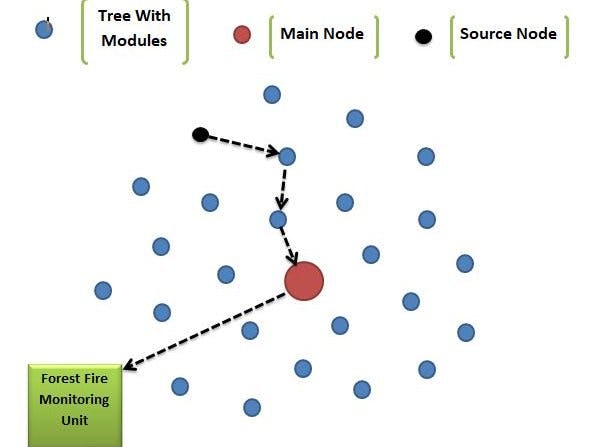The process of detection of forest fire initiates at any of the nodes planted on atree inside the forest. The forest has a network of nodes placed at suitable distances from each other, the nodes have a capability to communicate through devices ( RF module in our case) and by using Arduino. If any change above a threshold value is found in the atmospheric parameters (temperature rise, contamination of air with smoke, etc.) near a node (source node), the information is passed to a nearest intermediate node until it reaches to the main/head terminal. The main/head terminal uses a GSM modem to pass the information to a cell phone (the forest fire monitoring centre).
TRANSMITTER PART OF PHYSICAL MODELThe forest fire detection module works in three different stages. The first stageconsists of reading some external environmental parameters like temperature andsmoke. The first stage is done with the help of some sensors which are used tosense and convert analog data to digital data. The sensors read parameters liketemperature, humidity and air quality then sends this information to the nextnearest node. This process goes on until the information reaches to the finalnode or the main terminal which is the second stage of the overall process. Thethird stage consists of transmission of the information to the forest firemonitoring unit.
Eachnode has a temperature and humidity sensor, a smoke sensor and amicrocontroller unit. Arduino has been used as the microcontroller device. Thesensors interact with the Arduino and store the information for comparisonprocess. There is a predefined threshold value to each of these parameters. Themicroprocessor compares the sensor values at regular intervals of times withthe threshold values. Based on the comparison if the input values of sensorsexceed the threshold the node transmits the information to the next nearby nodewhich again in turn transmits the information to the other nearby node. In thisway the message flow is regulated in this model.
PHYSICAL MODEL OF THE APPARATUS




_ztBMuBhMHo.jpg?auto=compress%2Cformat&w=48&h=48&fit=fill&bg=ffffff)









Comments
Please log in or sign up to comment.